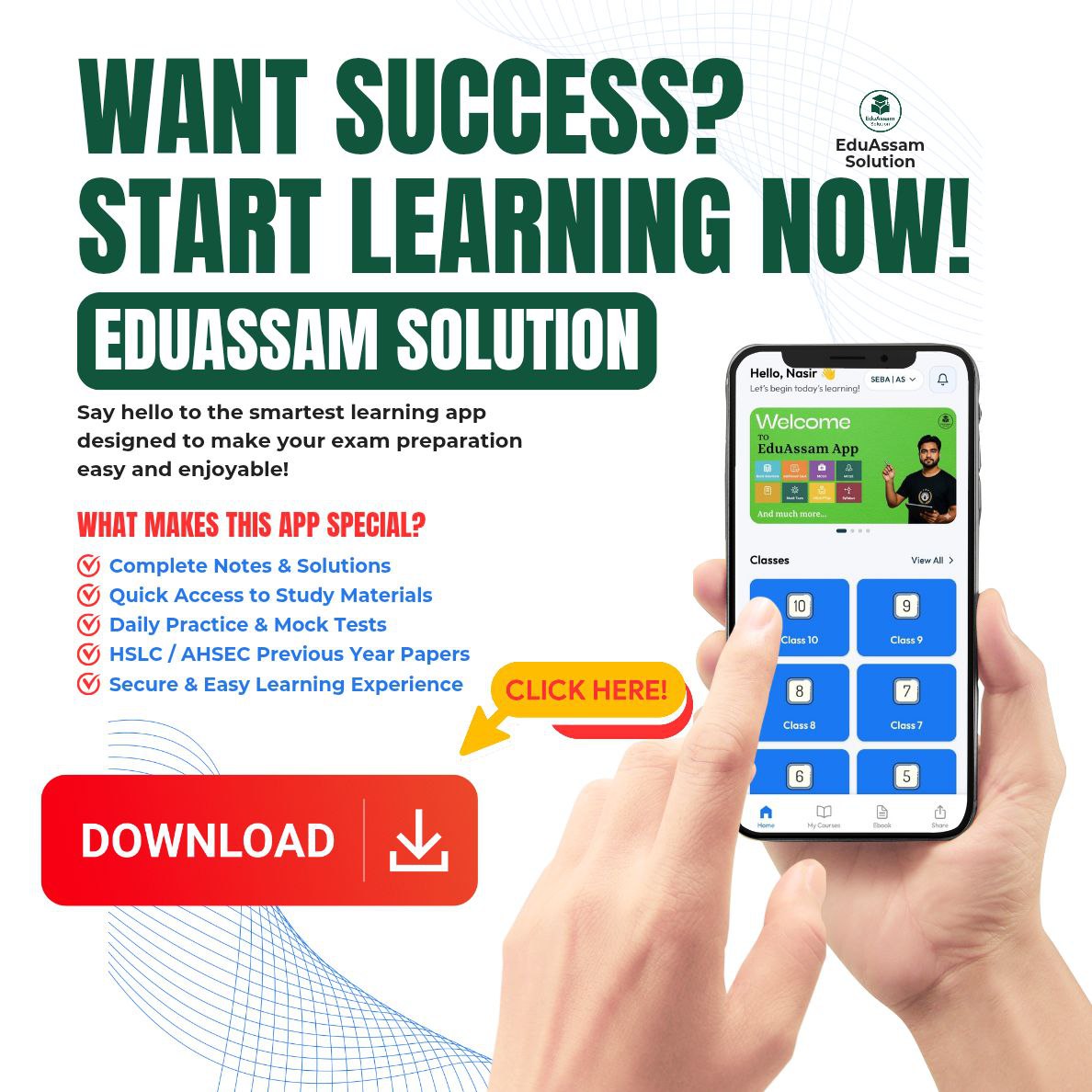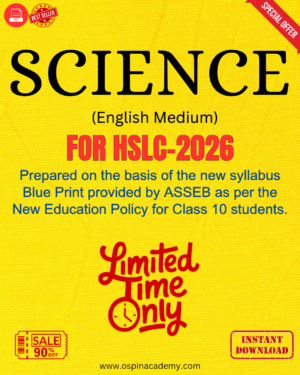SEBA Class 10 Science Chapter 16 – Management of Natural Resources Solutions & Summary
Looking for accurate solutions for Class 10 Science Chapter 16 – “Management of Natural Resources”? Ospin Academy provides detailed NCERT solutions for SEBA Assam students.
📖 Chapter Overview:
This chapter discusses the importance of sustainable resource management, conservation methods, and the need to balance resource use with environmental preservation.
📌 Key Topics Covered:
- Conservation and Sustainable Development
- Management of Forests and Wildlife
- Water Resource Management
- Coal and Petroleum Conservation
- Reduce, Reuse, Recycle (3Rs Principle)
📌 Important Questions for Exams:
- Why is sustainable management of natural resources important?
- Describe the 3Rs principle with examples.
- What are the major causes of deforestation and how can we control it?
- Explain the need for water conservation and sustainable use of water resources.
- Why should we conserve coal and petroleum? List two methods of conservation.
📝 How Ospin Academy Helps:
- Step-by-Step NCERT Solutions for SEBA Syllabus
- Conceptual Clarity with Diagrams and Examples
- Easy-to-Understand Chapter Notes for Quick Revision
- Practice Questions and Exam-Oriented Solutions
Access the best solutions for SEBA Class 10 Science Chapter 16 – “Management of Natural Resources” only on Ospin Academy!
Class 10 Science (English Medium) PDF Solutions 2025-26 | SEBA Assam
Download Class 10 Science (English Medium) PDF with detailed solutions, MCQs, and extra practice questions for SEBA Assam 2025-26.
Textual Questions and Answers:
Page – 269
1. What changes can you make in your habits to become more environment friendly?
Answer:- We can make the following changes in our habits to become more environment friendly.
1. Stop wastage of water.
2. Switching off unnecessary lights and fans.
3. Dont waste food.
4. Take as much as you require.
5. Walking down or use cycle for going to nearby market instead of using vehicle.
6. Separate wastes into recyclable and non-recyclable.
7. Reuse carry bags packing materials plastic containers and other reusable material.
2. What would be the advantage of exploiting resources with short term – aims?
Answer:- The exploitation of resources with short-term aims means the consumption of resources in such a way that they can help in achieving the short term goals without the concern for future generations.
The advantages of exploiting resources with short term aims will be:
- Industrial growth will be fast.
- The percentage of gains will be much higher in comparison to long term aims.
- Capital rotation will be faster.
- It will lead to rapid agricultural development.
3. How would these advantages differ from the advantages of using a long-term perspective in managing our resources?
Answer:- If the resources are used with long term perspective:
1. The demand of present as well as the future generations will be met.
2. There will be a lower level of pollution.
3. If the resources are used in the long run, there might be enough time for the resources to get replenished. In such a situation, no generation would be deprived of resources.
4. Why do you think there should be equitable distribution of resources? What forces would be working against an equitable distribution of our resources?
Answer:- Equitable distribution of resources is when every individual gets an equal right to access all the available resources and is benefited, directly or indirectly. Equitable distribution of resources is necessary as we all human beings, whether rich or poor have got equal rights on the usage of the resources. It also avoids the division of society to an extent.
The main forces which work against equitable distribution of resources include:
- Lack of natural resources.
- Excessive consumption by the rich.
- Profit motto by people exploiting resources.
- Corruption, etc.
Page – 273
1. Why should be conserve forests and wild life?
Answer:- It sustains life on the planet, provides clean air and shelter. Also, forests help conserve biodiversity. Forests provide many resources such as food, medicine, fabric, and raw materials.
The conservation of wildlife is necessary for prevention of drought, new deserts, fires as well as flood. Also, this conservation ensures that the upcoming generations of human and wildlife will be surrounded by nature thereby loving it and understanding the significance of wildlife.
2. Suggest some approaches towards the conservation of forests.
Answer:- Some approaches towards the conservation of forests are as follows:
(a) People should show their participation in saving the forest by protesting against the cutting of trees. For example, Chipko Andolan
(b) Planting of trees should be increased. Rate of afforestation must be more than that of deforestation.
(c) Some people cut precious trees such as Chandan to earn money. Government should take legal steps to catch these wood smugglers.
(d) Habitants of forests must not be bothered by the forest officials. Otherwise, this would result in the clash between tribal people and the government officials, thereby enhancing the naxal activities in forests.
Page – 276
1. Find out about the traditional systems of water harvesting / management in your region.
Answer. The traditional system of water harvesting in our region is the rooftop water harvesting using tanks. Tanks are kept at the roofs during rains. The rainwater gets collected in these tanks, and this rainwater can be used later for various household chores.
2. Compare the above systems with the probable systems in hilly/mountainous areas or plains mor plateau regions.
Answer:- Dams are built over rivers in hilly/mountainous areas. They are more advantageous because to store running river water which can be used to generate electricity. Moreover, since the water stored in dam keeps flowing to turn the turbines, it does not act as a breeding ground for mosquitoes which spread malaria. The stagnant water in ponds and cakes, however, becomes a breeding ground for mosquitoes.
3. Find out the source of water in your region/locality is water from this source available to all people living in that area?
Answer:- The source of water in our region is ground water. Water from the source is available to all the people living in that area.
EXERCISE
1. What changes would you suggest in your home in order to be environment friendly?
Answer:- (i) Use CFLS instead of traditional filament type electric bulbs:
1. Useless of plastic.
2. Use solar cooker to cook food whenever possible.
3. Eat as much you required but do not waste food.
4. Use water judiciously.
2. Can you suggest some changes in your school which would make it environment friendly?
Answer:- The changes that would make my school environment friendly are:
1. Save energy by turning off lights that we are not using.
2. I will suggest to buy recycled paper for decoration and other purposes.
3. Use writing paper on both the sides.
4. Growing trees and plants all around the play ground.
3. We saw in this chapter that there are four main stakeholders when it comes to forests and wildlife. Which among these should have the authority to decide the management of forest produce? Why do you think so?
Answer:- Because they are a branch of the government that is elected by the people, the government’s forest department should have the authority. These forest officials, on the other hand, must not be corrupt and must not accept payments from poachers or smugglers. The forest authorities can efficiently maintain and preserve forest regions by utilising government resources.
4. How can you as an individual contribute or make a difference to the management of
(a) Forests and wild life.
Answer:- The three ways in which an individual can contribute effectively to the management of forests and wildlife are as follows:
1. One should protest against the cutting of trees (deforestation).
2. One should protest against the poaching of wild animals.
3. One should stop the annexation of forest land for personal use.
(b) Water resources. And
Answer:- Water resources:
1. Turn the taps off while brushing or bathing and repair leaking taps.
2. We should practice rainwater harvesting.
3. We should avoid the discharge of sewage and other wastes into rivers and other water resources.
(b) Coal and petroleum?
Answer:- There are the two non-renewable resources that are used by every individual in form of fuel either for cooking or an automobile, in factories, in railways and so on.
5. What can you as an individual do to reduce your consumption of the various natural resources?
Answer:- Water, forests, coal, and petroleum, among other natural resources, are critical for human survival.
The following are some of the ways we can limit our use of various natural resources:
1. Deforestation should be avoided.
2. To limit the amount of trees cut down, we should utilise recycled paper.
3. We should not dispose of wastewater.
4. Rainwater harvesting should be practised.
5. To reduce the amount of petroleum we consume, we should carpool.
Alternative energy sources, such as hydropower and solar power, should be used.
6. List five things you have done over the last one week to:
(a) Conserve our natural resources.
Answer:- The five things done by me over the last one week conserve our natural resources were:
(i) Travel by a CNG bus for long distances and walk for short distances.
(ii) Use recycled paper.
(iii) Throw biodegradable and non-biodegradable waste into separate bins.
(iv) Plant trees.
(v) Harvest rainwater.
(b) Increase the pressure on our natural resources.
Answer:- To increase the pressure on our natural resources:
(i) Use non-renewable resources of energy.
(ii) Waste water.
(iii) Waste electricity.
(iv) Use plastics and polythene bags for carrying goods.
(v) Use escalators.
7. On the basis of the issues raised in this chapter, what changes would you incorporate in your life-style in a move towards a sustainable use of our resources?
Answer:- One should incorporate the following changes in life-style in a move towards a sustainable use of our resources:
(a) Stop cutting trees and practice plantation of trees.
(b) Stop using plastic and polythene bags for carrying goods.
(c) Use recycled paper.
(d) Throw biodegradable and non-biodegradable waste into separate bins.
(e) Waste minimum amount of water while using and repair leaking taps.
(f) Practice rainwater harvesting.
(g ) Avoid using vehicles for short distances. Instead, one can walk or cycle to cover short distances.
(h) To cover long distances, one should take a bus instead of using personal vehicles.
(i) Switch off electrical appliances when not in use.
(j) Use fluorescent tubes in place of bulbs to save electricity.
(k) Take stairs and avoid using lifts.
(l) During winters, wear an extra sweater to avoid using heaters.
SEBA Class 10 Science Chapter 16 – Management of Natural Resources FAQs
Get Free NCERT PDFs
If you want to download free PDFs of any chapter, click the link below and join our WhatsApp group:


